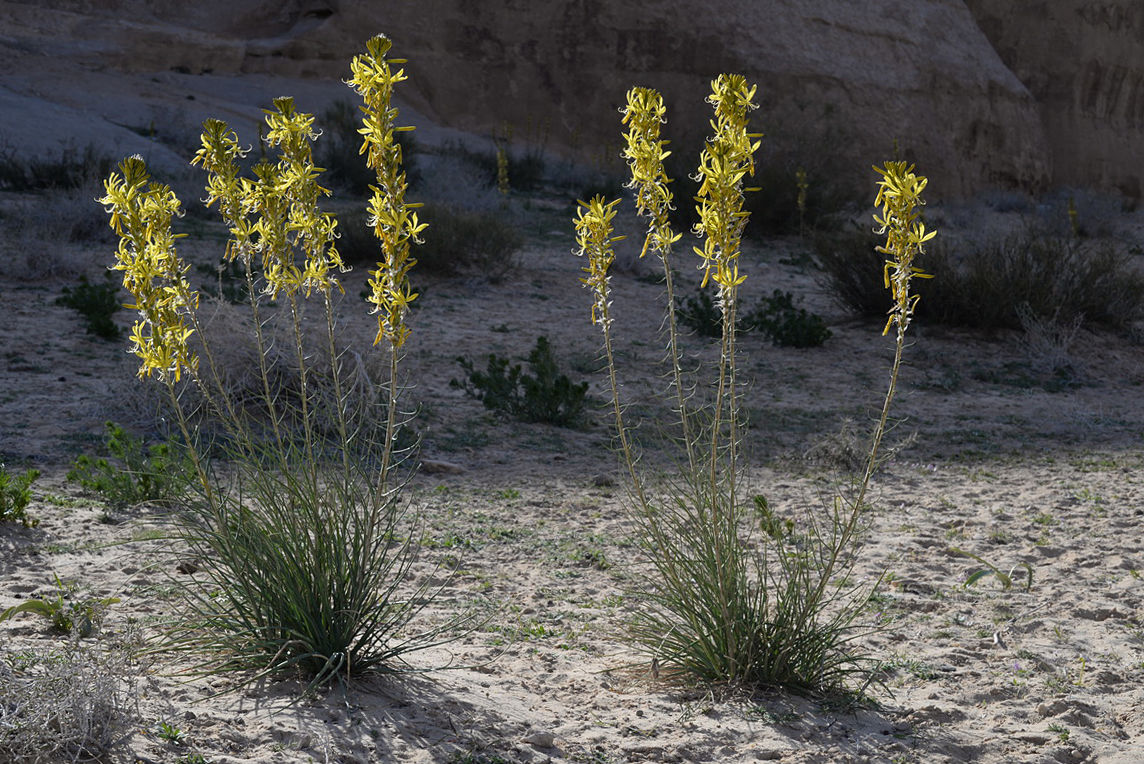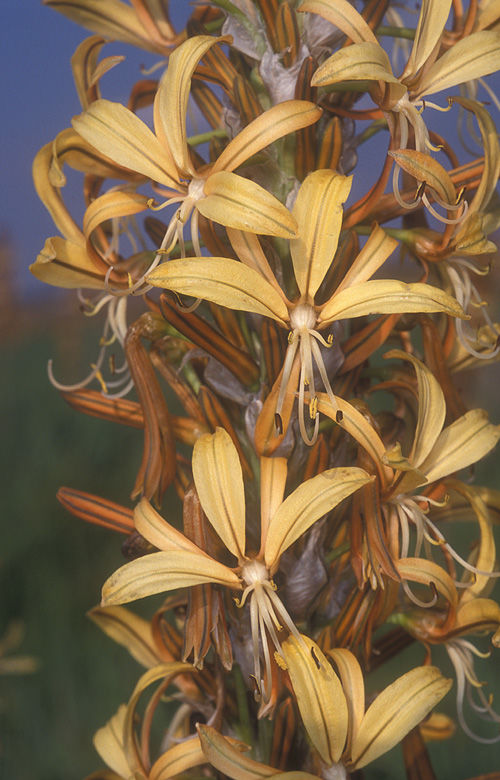Family: Asphodelaceae
Author: (L.) Rchb.
Bibliography: Fl. Germ. Excurs.: 116 (1830)
Year: 1830
Status: accepted
Rank: species
Genus: Asphodeline
Vegetable: False
Observations: Medit. to Caucasus
Description
King’s-spear, known scientifically as Asphodeline lutea, is a striking and resilient perennial plant belonging to the Asphodelaceae family. This remarkable species was first documented in 1830 in the botanical literature “Flora Germanica excursoria” on page 116, authored by the esteemed botanist Ludwig Reichenbach, hence denoted as (L.) Rchb. in scientific citations.
Native to the Mediterranean regions stretching to the Caucasus, King’s-spear thrives in a variety of environments within this extensive geographical range. Noted for its singular beauty and hardiness, the plant typically features tall, slender stems crowned with brilliant yellow flowers that bloom in late spring to early summer, creating a radiant display.
The leaves of King’s-spear are linear and grass-like, forming a dense clump at the base, allowing the vibrant yellow flower spikes to rise prominently above. These floral spikes can reach impressive heights, often growing between one to four feet tall, making them a striking addition to any garden or natural setting.
Asphodeline lutea is valued not only for its ornamental appeal but also for its adaptability. It is known to tolerate poor, dry soils, making it an excellent choice for xeriscaping and other low-water landscaping applications. The plant’s resilience and minimal maintenance requirements further contribute to its popularity among gardeners and landscapers.
In its natural habitat, King’s-spear is often found in rocky and stony areas, thriving in full sun exposure where other plants might struggle. Its ability to withstand harsh Mediterranean climates—with hot, dry summers and mild, wet winters—demonstrates its hardiness and tenacity.
Cultivating Asphodeline lutea can offer numerous ecological benefits, including providing habitat and nourishment for various pollinators, such as bees and butterflies. Its stunning yellow blossoms serve as an important source of nectar and pollen, supporting local biodiversity.
Whether admired in the wild or cultivated in domestic gardens, King’s-spear stands as a testament to the beauty and resilience of nature, offering a bright splash of color and a touch of elegance to the landscapes it adorns.
Common Names
Eng: jacob’s-rod, king’s-spear, yellow asphodel
Dan: kejserlys
Swe: junkerlilja
En: King’s-spear, Yellow asphodel, Jacob’s-rod
Ar: عصفلدين أصفر
Hy: Թաղաղու դեղին
Be: Асфадэліна жоўтая
Bg: Жълто асфоделине
Zh: 日光兰
Cs: Asfodelína žlutá
Da: Kejserlys
Fi: Keltasoihtu, Keltasoihdukki
De: Gelber Affodill
El: Ασφοδελίνη η κίτρινη
He: עיריוני צהוב
It: Asfodelo giallo
Pl: Złotnica żółta
Sv: Junkerlilja
Zh-tw: 日光蘭
Uk: Золотень жовтий
Synonyms
- Dorydium luteum ((L.) Salisb.)
- Asphodelus luteus (L.)
Distribution
- Albania (native)
- Algeria (native)
- Bulgaria (native)
- Cyprus (native)
- East Aegean Is. (native)
- Greece (native)
- Italy (native)
- Kriti (native)
- Krym (native)
- Lebanon-Syria (native)
- North Caucasus (native)
- Palestine (native)
- Romania (native)
- Sicilia (native)
- Transcaucasus (native)
- Tunisia (native)
- Turkey (native)
- Turkey-in-Europe (native)
- Yugoslavia (native)
Additional Images
Leaf
Taken May 15, 2022 by Fabrice Rubio (cc-by-sa)
Taken Jun 21, 2022 by David Hocken (cc-by-sa)
Taken Jun 21, 2022 by David Hocken (cc-by-sa)
Taken May 30, 2020 by Irmgard Groß (cc-by-sa)
Taken Apr 23, 2022 by VikCastle (cc-by-sa)
Flower
Taken Apr 19, 2013 by Tela Botanica − Yoan MARTIN (cc-by-sa)
Taken Jun 10, 2020 by Wittmer Irina (cc-by-sa)
Taken May 6, 2020 by Sambin (cc-by-sa)
Taken Apr 23, 2019 by iannizzotto michele (cc-by-sa)
Habit
Taken Apr 22, 2014 by Tela Botanica − Liliane Roubaudi (cc-by-sa)
Taken Apr 19, 2013 by Tela Botanica − Yoan MARTIN (cc-by-sa)
Taken May 15, 2022 by Fabrice Rubio (cc-by-sa)
Taken May 30, 2020 by Irmgard Groß (cc-by-sa)
Taken May 30, 2020 by Irmgard Groß (cc-by-sa)
Fruit
Taken Apr 22, 2014 by Tela Botanica − Liliane Roubaudi (cc-by-sa)
Taken Jun 6, 2009 by Tela Botanica − Yoan MARTIN (cc-by-sa)
Taken May 30, 2020 by Irmgard Groß (cc-by-sa)
Taken May 15, 2022 by Fabrice Rubio (cc-by-sa)
Taken Jul 14, 2021 by nieto victoria (cc-by-sa)
Bark
Taken Apr 23, 2018 by De Lanriec Annie (cc-by-sa)
Taken Jun 19, 2020 by Kerstin Kerstin (cc-by-sa)
Taken Jun 9, 2021 by Dieter Albrecht (cc-by-sa)
Taken Apr 12, 2022 by Enrico L. (cc-by-sa)
Taken Apr 19, 2013 by Tela Botanica − Yoan MARTIN (cc-by-sa)

© copyright of the Board of Trustees of the Royal Botanic Gardens, Kew.

© copyright of the Board of Trustees of the Royal Botanic Gardens, Kew.

© copyright of the Board of Trustees of the Royal Botanic Gardens, Kew.
Other
Taken Apr 16, 2022 by Elie Eid (cc-by-sa)
Sources
- WFO (No URL)
- IPNI (No URL)
- GBIF (https://www.gbif.org/species/2777134)
- POWO (http://powo.science.kew.org/taxon/urn:lsid:ipni.org:names:531414-1)
- PlantNet (https://identify.plantnet.org/species/the-plant-list/Asphodeline lutea (L.) Rchb.)

























